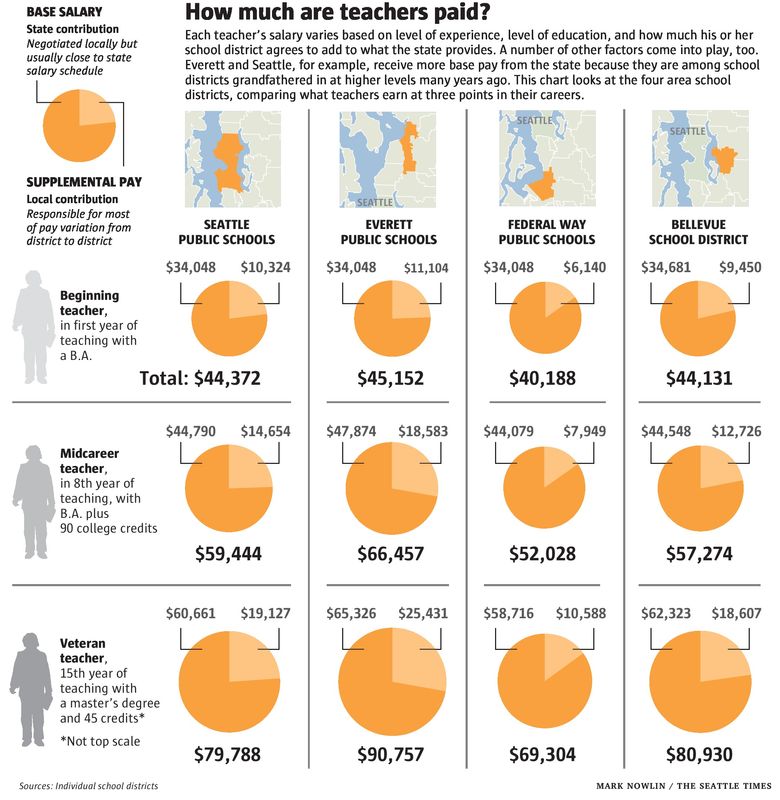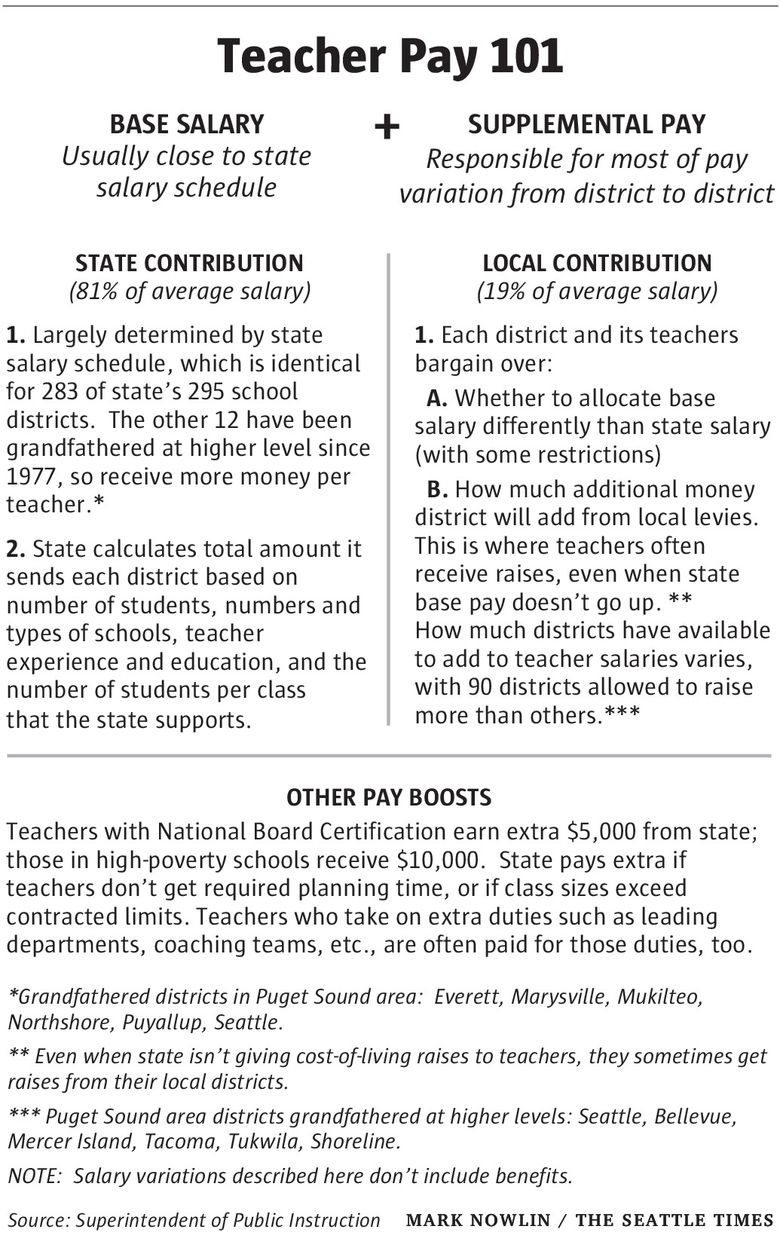Wildly varying teacher salaries part of state budget debate

When it comes to adequately funding Washington’s public schools, the state Supreme Court says teacher pay is key.
In the landmark McCleary case that’s at the center of budget negotiations in Olympia this year, the justices ruled that the state doesn’t give school districts nearly enough to cover the true cost of a basic public education, which is what the state constitution requires.
State funding falls short, they wrote, for everything from textbooks to school buses to salaries for principals, librarians, custodians — and teachers, the largest group of school employees.
Just how much more money lawmakers need to put toward teacher compensation, and where those dollars come from, are among the Legislature’s most hotly contested issues as lawmakers wrestle with how to find enough money to fulfill the court’s orders.
The proposals for compensation alone, early estimates show, range from $1.3 billion to $2.2 billion a year once they are fully phased in.“Of the whole McCleary debate, the biggest issue is compensation,” said Chris Vance, who once chaired the state Republican Party and now works part-time for the state’s education department.
That doesn’t mean that teacher pay is necessarily about to skyrocket. Most of the proposals to increase the state’s share of teacher pay also require the contribution from local taxpayers to go down.
That’s because the court’s main message is that the state pays too little — not that pay overall is too low.
“It’s not an adequacy (issue), it’s more of a ‘who pays?’ problem,” said Sen. Bruce Dammeier, R-Puyallup, the author of one proposal to lower the amount of local school levies and raise the state’s property tax by roughly the same amount — an idea sometimes referred to as a levy swap.
But total pay is part of the debate, too, as well as bringing more coherence to a salary system that now varies wildly from district to district, with teachers in some parts of the state making tens of thousands of dollars more than colleagues who sometimes don’t live all that far away.
Some also have proposed paying teachers in high-cost communities more than those in low-cost areas, ending the practice of providing the same base salary whether a teacher lives in Bellevue or Brewster.
The justices offered little concrete guidance on any of these issues. While they wrote in the McCleary ruling that “substantial evidence” showed the state has consistently underfunded salaries for teachers and administrators — and their benefits, too — they didn’t provide any specific amount, instead encouraging lawmakers to carry out promises in a bill passed in 2009 that called for, among other things, a study of how wages should change.
But the justices were clear that school districts today rely too heavily on local property-tax levies to pay teachers and other school employees.
Ruling not the first
Teacher pay, a complicated mix of state and local dollars, has always been a contentious issue.
The state adopted its current way of paying teachers in the 1970s, after the first time the Supreme Court ruled that state lawmakers were failing to adequately fund public schools.
That base salary is supposed to cover about 1,000 instructional hours over 180 school days each year, plus some planning time. The schedule also includes built-in salary increases for the first 10 to 15 years of teachers’ careers, based on their level of education and years of experience.
Local districts could still supplement what the state provided, but not as much as they do now. The local contributions started to pick up in the late 1980s, when lawmakers started to relax how much local districts could add to what teachers earn.
The local pay is supposed to be for extra tasks, such as planning time before or after the school year. It came to be known as TRI pay, for extra time, responsibility and incentive.
In the McCleary decision, the court noted that the local contribution has increased a lot over the years, citing those who say districts use TRI pay as a de facto cost-of-living adjustment, especially when the state wasn’t providing one. While the Washington Education Association — which represents the state’s K-12 teachers — still insists that TRI money is for extra time and responsibility, some say those local contributions have essentially become a part of a teacher’s salary.
Over the years, a patchwork of policies and practices has led to big variations in pay from district to district.
Twelve districts, for example, get more salary dollars from the state because they were grandfathered in at a higher base pay back when the state salary schedule was first adopted.
Everett is among them, one reason why teacher salaries are higher there. An Everett teacher with eight years of experience, for example, can now make $66,457, while the same teacher in Yakima would make $49,163.
On average, the state covers about 81 percent of teachers’ salaries, and local districts make up the rest, roughly $13,000 per teacher.
The local share for school administrators is even greater, with districts Wildly varying teacher salaries part of state budget debate | The Seattle Times:


